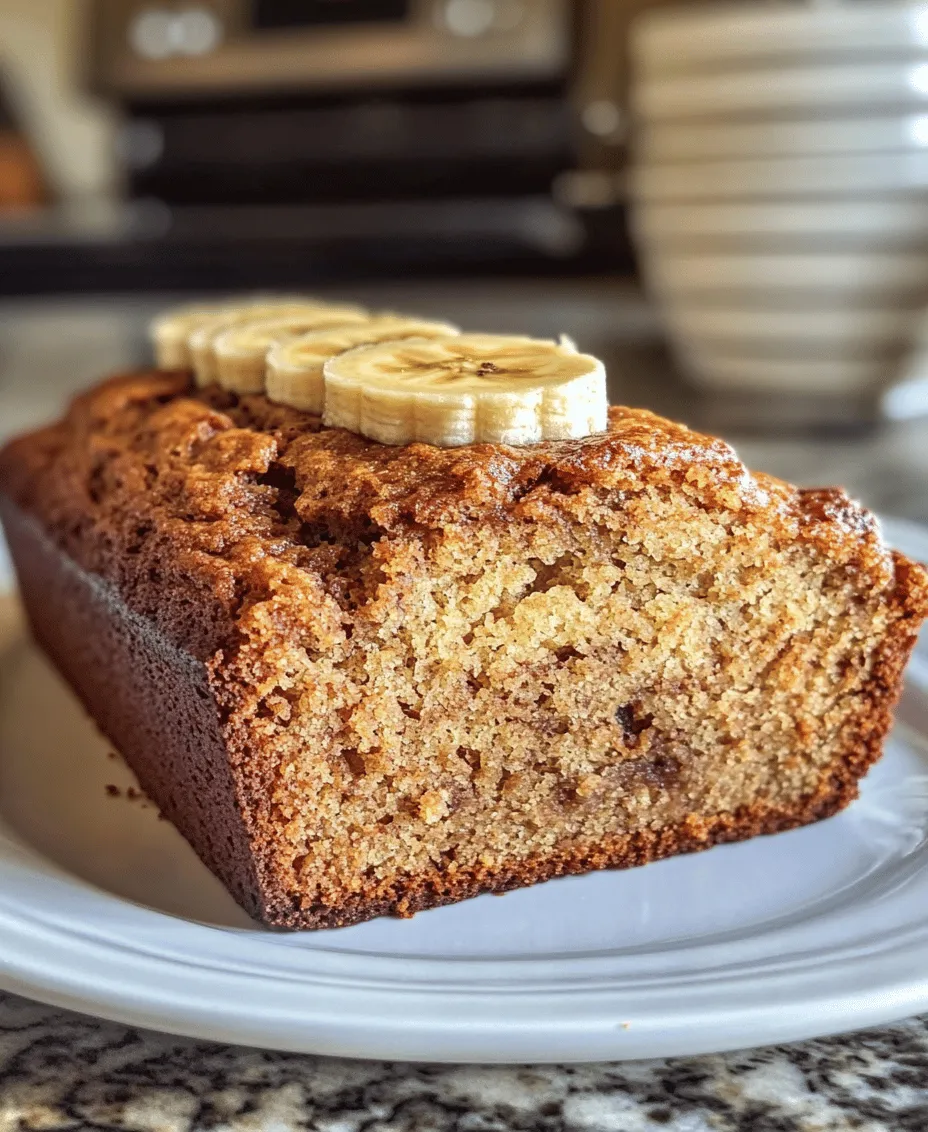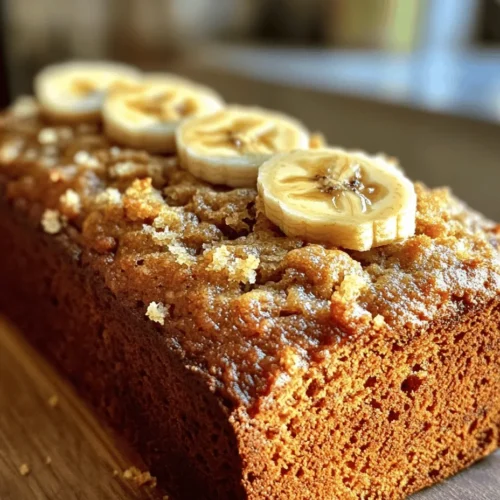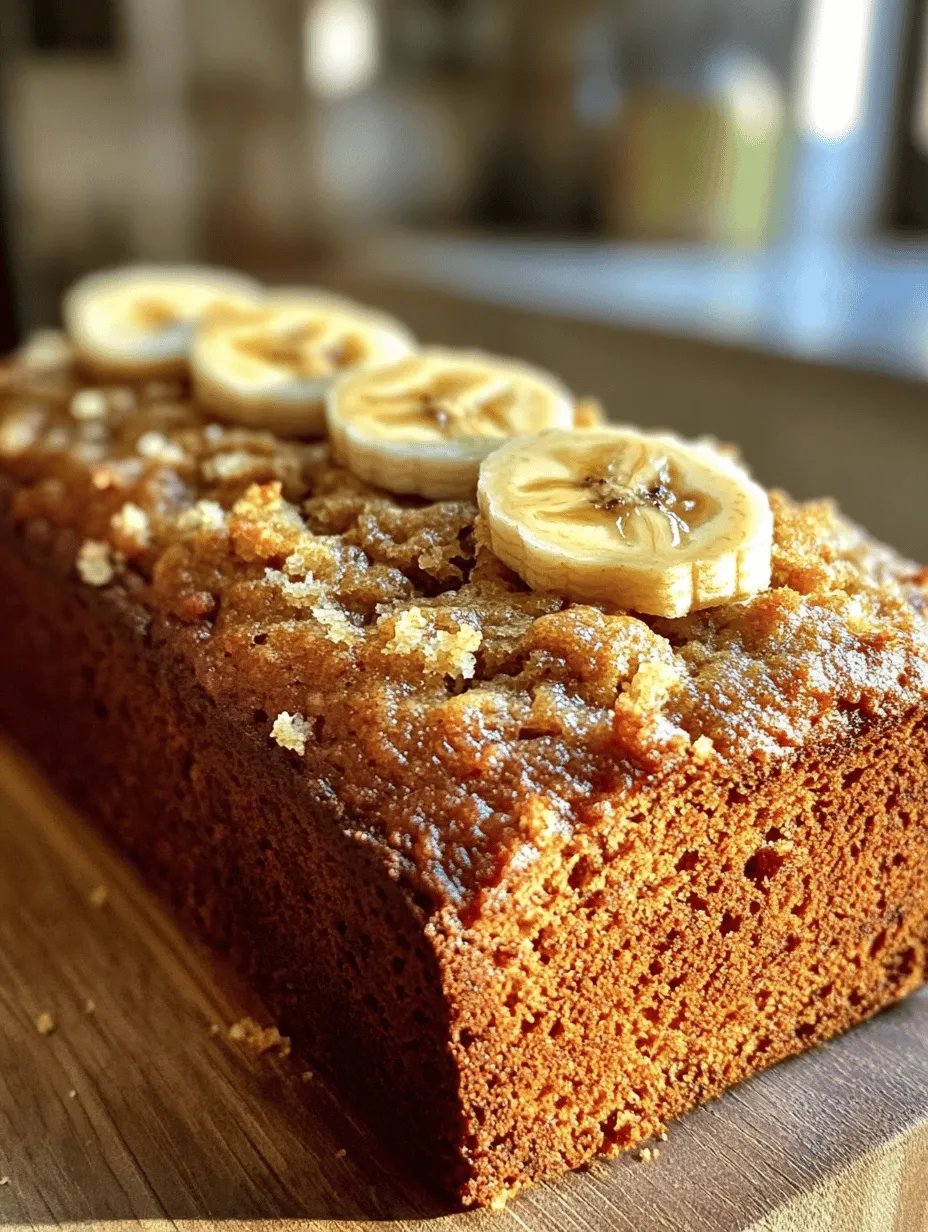Introduction to Simple & Sweet 3-Ingredient Banana Bread
Banana bread has long held a beloved place in the hearts of bakers and snackers alike. Its comforting aroma wafting through the kitchen brings nostalgia for many, often evoking memories of family gatherings, warm afternoons, and cozy breakfasts. This versatile baked good has become a staple in kitchens around the world. Whether enjoyed fresh from the oven or toasted with a smear of butter, banana bread is a delightful treat that can be customized to suit a variety of tastes.
What sets this Simple & Sweet 3-Ingredient Banana Bread apart is its remarkable simplicity. With just three key ingredients—ripe bananas, nut butter, and eggs—this recipe is incredibly accessible for bakers of all skill levels. You don’t need to be a culinary expert to whip up a delicious loaf; in fact, this recipe is perfect for beginners and experienced bakers alike who are looking for a quick, straightforward option. The minimal ingredient list not only streamlines the baking process but also ensures that you can create a tasty treat without the fuss.
Beyond its simplicity, this banana bread boasts impressive health benefits. Ripe bananas provide natural sweetness and moisture, while nut butter contributes healthy fats and protein. Together, these ingredients create a nourishing loaf that can satisfy your cravings without compromising your wellness goals. The final product is a delightful combination of flavors and textures—moist, sweet, and with a hint of nuttiness that makes each bite a joy.
The Appeal of 3-Ingredient Recipes
In recent years, there has been a noticeable trend towards minimalism in cooking and baking. Many home cooks are embracing the idea of fewer ingredients, and for good reason. Recipes that require only a handful of components not only save time but are also often more cost-effective. By reducing the number of ingredients, you can create delicious meals and snacks while minimizing food waste—a significant boon in today’s eco-conscious culinary landscape.
The appeal of this 3-ingredient banana bread lies not only in its simplicity but also in its versatility. This recipe can easily be adapted to accommodate various dietary preferences. Whether you follow a gluten-free diet, are dairy-free, or simply wish to experiment with flavors, this banana bread can be tailored to fit your needs. For instance, you can swap out the nut butter for sunflower seed butter if you have nut allergies, or add in spices such as cinnamon or vanilla for an extra flavor kick. This adaptability makes the recipe a fantastic option for families with diverse dietary requirements.
Understanding the Ingredients
Ripe Bananas
The star ingredient of this recipe, ripe bananas, are packed with nutritional benefits. They are high in potassium, which supports heart health and helps regulate blood pressure. Additionally, bananas are a good source of dietary fiber, promoting digestive health, and they contain essential vitamins such as vitamin C and vitamin B6.
When selecting bananas for your banana bread, look for ones that are well-ripened—those with brown spots on their skin are perfect. These bananas will yield the best flavor and sweetness, as their starches have broken down into sugars. The natural sugars in ripe bananas not only sweeten the bread but also contribute to its moist texture, making them an indispensable element of this recipe.
Nut Butter Options
Nut butter is the second key ingredient in our banana bread, adding richness and flavor. The two most popular choices are peanut butter and almond butter, each bringing unique flavor profiles to the table.
Peanut butter has a slightly sweet and nutty taste, while almond butter is creamier and offers a more subtle nuttiness. Nutritionally, both options provide healthy fats, protein, and various vitamins and minerals, making them excellent choices for enhancing the nutritional profile of your banana bread.
However, it’s important to consider dietary restrictions. Those with nut allergies can easily substitute nut butter with sunflower seed butter or another nut-free option. The choice of nut butter will impact the final texture of your banana bread, with thicker varieties yielding a denser loaf, while creamier options create a lighter, fluffier texture.
Eggs: The Binding Agent
Eggs play a crucial role in this banana bread recipe, serving as the binding agent that holds all the ingredients together. They contribute moisture and structure, ensuring that your loaf rises appropriately and has a pleasant texture. The proteins in eggs coagulate when heated, creating a stable structure that prevents the bread from crumbling apart.
For those who prefer a vegan or egg-free option, several substitutes can be utilized. Common alternatives include flaxseed meal mixed with water, applesauce, or a commercial egg replacer. Each substitute will yield slightly different results, but they can effectively replicate the binding properties of eggs while allowing you to enjoy delicious banana bread without compromise.
Step-by-Step Instructions for Perfect Banana Bread
Preparing Your Kitchen and Ingredients
Before diving into the mixing process, it’s essential to prepare your kitchen and gather all necessary ingredients. Start by preheating your oven to 350°F (175°C). Preheating is a critical step in baking, as it ensures that your banana bread bakes evenly throughout. An oven that is not adequately heated can lead to uneven rising and may result in a dense loaf.
Next, select the right baking pan. A standard 9×5 inch loaf pan is ideal for this recipe, providing enough space for the bread to rise without overflowing. To prevent sticking, lightly grease the pan with cooking spray or line it with parchment paper. This will make it easier to remove the bread once it’s baked, ensuring that you have a lovely, intact loaf to enjoy.
Mixing the Batter
Now that your kitchen is prepped, it’s time to mix the batter. Start by mashing your ripe bananas in a large mixing bowl until smooth. You can use a fork or a potato masher for this task—whichever you prefer. The mashed bananas should be free of lumps for an even texture in the final product.
Once your bananas are mashed, add in the nut butter of your choice. Stir the two ingredients together until they are well combined. The mixture should become creamy and smooth, with the nut butter fully incorporated into the bananas. This step is crucial as it ensures that the nutty flavor permeates the bread.
Next, crack your eggs into the banana and nut butter mixture. Whisk the ingredients together until they are fully blended. The eggs should be evenly distributed throughout the batter, creating a uniform consistency. At this stage, feel free to add any optional ingredients, such as spices, chocolate chips, or nuts, to customize your banana bread further.
After your batter is mixed, it should be thick yet pourable. Pour the batter into your prepared loaf pan, smoothing the top with a spatula if necessary. This step will help ensure even baking and a beautiful presentation once the bread is done.
With your banana bread batter now ready, you are just moments away from enjoying a delicious homemade treat. Place the loaf pan in the preheated oven and allow it to bake for approximately 45-55 minutes, or until a toothpick inserted into the center comes out clean.
Stay tuned for the next part of the recipe where we will explore tips for ensuring your banana bread turns out perfectly and answer some common questions about this delightful treat.

Tips for Mashing Bananas for the Best Texture
Achieving the perfect texture for your banana bread starts with how you mash the bananas. For a smooth and creamy consistency, use fully ripe bananas that have plenty of brown spots. These bananas are not only sweeter but also more flavorful. Here are some tips for mashing bananas effectively:
1. Use a Fork or Potato Masher: A fork or a potato masher is ideal for breaking down the bananas. Begin by peeling the bananas and placing them in a large bowl. Use the fork to press down on the bananas, gradually mashing them into a smooth puree. If you prefer a chunkier texture, mash them lightly, leaving some small pieces.
2. Mash in Batches: If you have several bananas, consider mashing them one at a time or in smaller batches. This ensures that each banana gets evenly mashed, resulting in a consistent texture throughout your bread.
3. Avoid Over-Mashing: While a smooth consistency is desired, avoid over-mashing the bananas to the point where they become too watery. You want a thick puree that can hold its shape but still blends well with the other ingredients.
Techniques for Ensuring the Nut Butter and Eggs Are Well Incorporated
To ensure your banana bread has a uniform texture and flavor, it’s essential to thoroughly incorporate the nut butter and eggs into the mashed bananas. Here are some effective techniques:
1. Room Temperature Ingredients: Make sure your nut butter and eggs are at room temperature before mixing. This helps them blend more easily into the banana mixture, creating a smoother batter.
2. Mixing Method: Start by combining the mashed bananas and nut butter in a large mixing bowl. Use a spatula or whisk to mix them together until they are well combined. Then, add the eggs one at a time, mixing well after each addition. This method ensures that the eggs are fully incorporated without leaving any lumps.
3. Avoid Over-Mixing: Once you add the flour and other dry ingredients (if using), mix just until combined. Over-mixing can lead to tough banana bread, so it’s better to have a few small lumps than to overwork the batter.
Avoiding Common Mistakes: Checking for Lumps and Achieving a Smooth Batter
Achieving the perfect batter is crucial for a successful banana bread. Here are common pitfalls to avoid:
1. Check for Lumps: After mixing, take a moment to inspect the batter. Look for any lumps of flour or nut butter that may not have been fully incorporated. If you do see any, gently fold the mixture with a spatula until the lumps are gone.
2. Consistency Check: The batter should be thick but pourable. If it feels too dry or crumbly, add a little more nut butter or mashed banana to adjust the consistency.
3. Baking Pan Preparation: Ensure your baking pan is properly greased or lined with parchment paper to prevent sticking. A well-prepared pan makes it easier to remove the banana bread after baking.
Baking the Banana Bread
Timing and Temperature: Why It’s Crucial to Monitor the Baking Process
Baking banana bread requires attention to time and temperature to ensure an evenly baked loaf. Here’s how to get it right:
1. Preheat the Oven: Always preheat your oven to 350°F (175°C) before placing your banana bread in. This ensures that the bread starts baking immediately, promoting even cooking.
2. Baking Time: Generally, banana bread will take about 45-60 minutes to bake, depending on your oven and the size of your loaf. Start checking for doneness around the 45-minute mark.
3. Oven Position: Place the banana bread in the center of the oven to promote even heat distribution. Avoid opening the oven door too frequently, as this can cause the bread to sink in the center.
Signs of Doneness: How to Check for the Perfect Bake Using a Toothpick Test
Knowing when your banana bread is done baking is essential. The toothpick test is a reliable method:
1. Toothpick Test: Insert a toothpick or a skewer into the center of the loaf. If it comes out clean or with a few moist crumbs, your banana bread is done. If it comes out wet with batter, it needs more time in the oven.
2. Color Check: The bread should be golden brown on top. If it’s browning too quickly, you can loosely cover the top with aluminum foil to prevent it from burning while the inside continues to bake.
3. Slightly Pull Away from Sides: Another sign of doneness is when the edges of the bread start to pull away from the sides of the pan.
Cooling Considerations: Importance of Letting the Bread Rest Before Slicing
Allowing your banana bread to cool properly is essential to maintaining its texture:
1. Cooling Time: After removing the banana bread from the oven, let it cool in the pan for about 10-15 minutes. This makes it easier to remove without breaking.
2. Transfer to Wire Rack: After the initial cooling, transfer the bread to a wire rack to cool completely. This helps prevent sogginess, allowing air to circulate around the bread.
3. Slicing: Wait until the bread is completely cool before slicing. Cutting too soon can result in a gummy texture and make it difficult to get clean slices.
Flavor Variations and Add-Ins
Exploring Flavor Profiles
While the three ingredients create a simple and delicious banana bread, you can enhance its flavor profile by adding spices and other ingredients:
1. Spices: Consider adding a teaspoon of cinnamon or nutmeg to the batter for a warm, comforting flavor. A splash of vanilla extract can also elevate the taste, bringing out the natural sweetness of the bananas.
2. Chocolate Chips or Nuts: For added texture and flavor, fold in a half cup of chocolate chips or chopped nuts such as walnuts or pecans. These additions create a delightful contrast to the soft bread.
Customizing for Dietary Needs
Banana bread can easily be adjusted to fit various dietary preferences and needs:
1. Gluten-Free Options: Substitute regular flour with gluten-free nut flour or a gluten-free all-purpose blend. This makes the bread suitable for those with gluten sensitivities without compromising on taste.
2. Reducing Sugar: If you’re looking to make a healthier version, you can reduce the amount of nut butter or substitute it with unsweetened applesauce. This maintains moisture and sweetness without adding excess sugar.
Serving Suggestions and Pairings
Enjoying Banana Bread
Banana bread is incredibly versatile when it comes to serving:
1. Ideal Serving Methods: Serve your banana bread warm from the oven for a comforting treat. Toasted slices are equally delicious, bringing out the flavors even more.
2. Pairing Suggestions: Enhance your banana bread experience with a spread of butter, honey, or Greek yogurt. These toppings add creaminess and richness, complementing the sweetness of the bread.
Creative Uses for Leftover Banana Bread
If you find yourself with leftover banana bread, don’t worry; there are plenty of creative ways to use it:
1. French Toast: Transform stale banana bread into a decadent French toast by dipping slices in an egg mixture and pan-frying until golden brown.
2. Bread Pudding: Use leftover bread to make a delicious bread pudding. Combine with milk, eggs, and spices, then bake until set for a comforting dessert.
3. Smoothies: Blend pieces of banana bread into your morning smoothie for an added boost of flavor and nutrition.
4. Proper Storage: To maintain freshness, wrap the banana bread tightly in plastic wrap or aluminum foil and store it at room temperature for up to three days. For longer storage, consider freezing slices.
Nutritional Information Breakdown
Understanding the nutritional value of your banana bread can help you make informed choices. Here’s a general breakdown per slice of banana bread (assuming a standard loaf yields about 10 slices):
– Calories: Approximately 150-200 calories
– Total Fat: 6-10 grams (depending on nut butter type)
– Carbohydrates: 22-30 grams
– Protein: 3-5 grams
Each ingredient in your banana bread contributes to its nutritional profile:
– Bananas: Rich in potassium, fiber, and vitamins B6 and C, bananas support heart health and digestion.
– Nut Butter: Provides healthy fats, protein, and essential nutrients like vitamin E and magnesium.
– Eggs: A great source of protein and various vitamins, eggs help bind the ingredients together and improve the bread’s texture.
Conclusion: The Simplicity and Satisfaction of Homemade Banana Bread
Making a simple and sweet 3-ingredient banana bread is not only easy but also immensely satisfying. The combination of ripe bananas, nut butter, and eggs creates a moist, flavorful loaf that can be enjoyed in numerous ways. As you experiment with different flavor variations and serve it alongside your favorite toppings, you’ll discover the joy of customizing this classic recipe to suit your taste.
Baking is a rewarding experience that brings warmth to your kitchen and delicious aromas that fill the air. Whether you’re sharing it with friends and family or enjoying a quiet moment with a slice and a cup of tea, homemade banana bread is a delightful treat. So gather your ingredients, follow the steps, and embrace the creativity that baking inspires. Your kitchen is about to become the heart of delicious memories.



